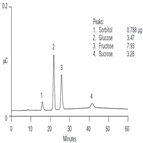Find methods for your needs
Refine by Feature
Displaying 1-3 of 3 results for Tag: Candy
Identification of Lysergic Acid Diethylamide (LSD) in Candy by UHPLC/MS
Instrument Type: LCMSLysergic acid diethylamide (LSD) is a controlled substance in forensic chemistry that is notorious for being difficult to identify. Its myriad evidentiary forms include paper tabs, eye drops, sugar cubes and small sugary candies such as sweet tarts, valentine hearts or mints. Most forensic laboratories confirm the presence of LSD by using gas chromatography with mass spectrometry (GC/MS). We describe the benefits of a method to positively identify trace amounts of lysergic acid diethylamide (LSD) in sugar candy quickly, with minimal sample preparation and no chemical derivatization.
AN87: Determination of Sugar Alcohols in Confections and Fruit Juices by HPAE-PAD
Instrument Type: ICSugar alcohols are used in confectionary products because they impart a sweet taste without the calories associated with sugars. Their use in foods is regulated due to their laxative and diuretic properties. This application note uses the Dionex CarboPac MA1 column and pulsed amperometric detection to determine sugar alcohols without the need for derivitization or postcolumn reagents.
AN147: Determination of Polydextrose in Foods by AOAC Method 2000.11
Instrument Type: ICThis application note shows our participation in a successful AOAC collaborative study that resulted in AOAC Method 2000.11.2 Polydextrose is separated on a CarboPac PA1 column and detected by PAD using a triple-potential waveform (Waveform B, Dionex Technical Note 21). A quadruple-potential waveform (Waveform A, TN21) provides greater long-term reproducibility of peak area response compared to Waveform B. We analyzed samples with both waveforms. This application note shows that Waveform A produced results equivalent to those obtained with Waveform B.



